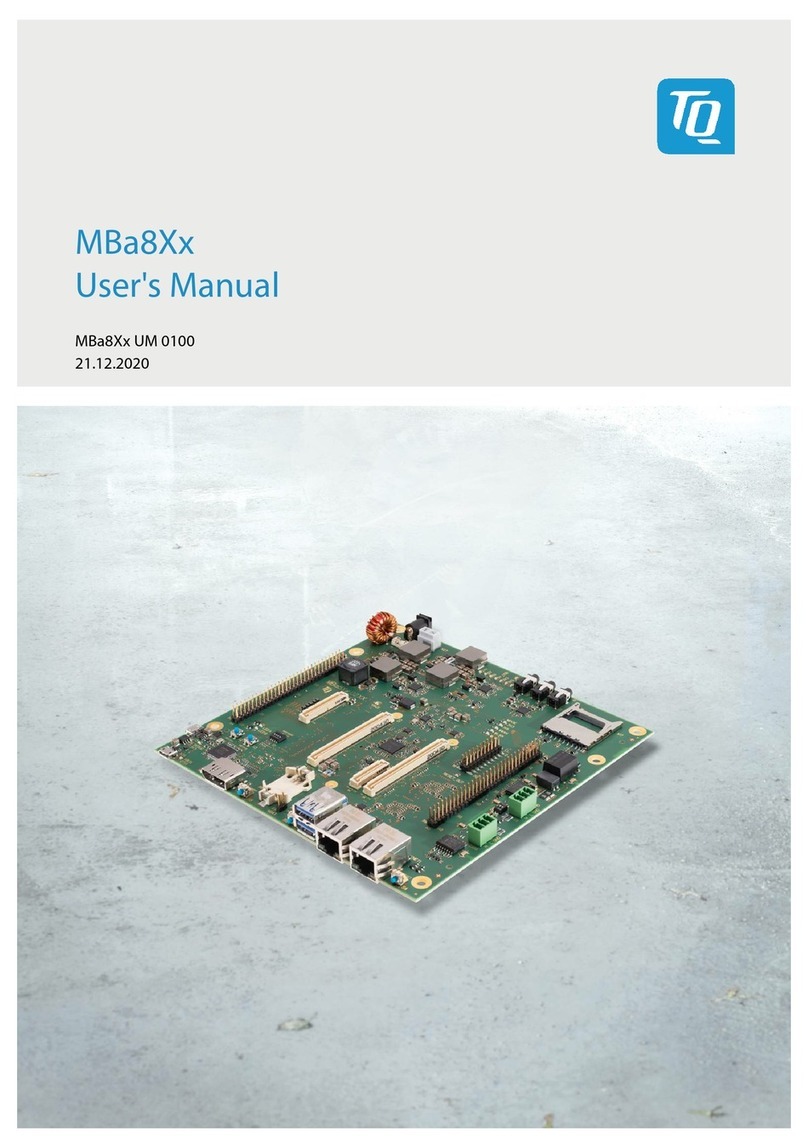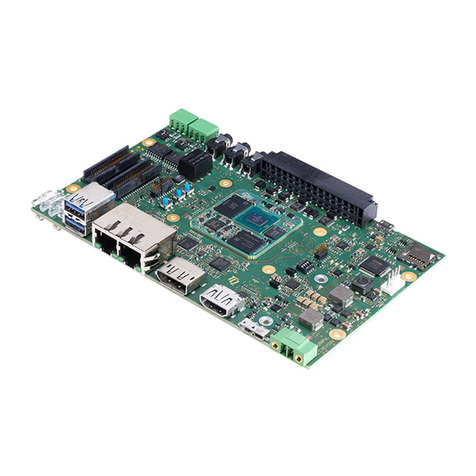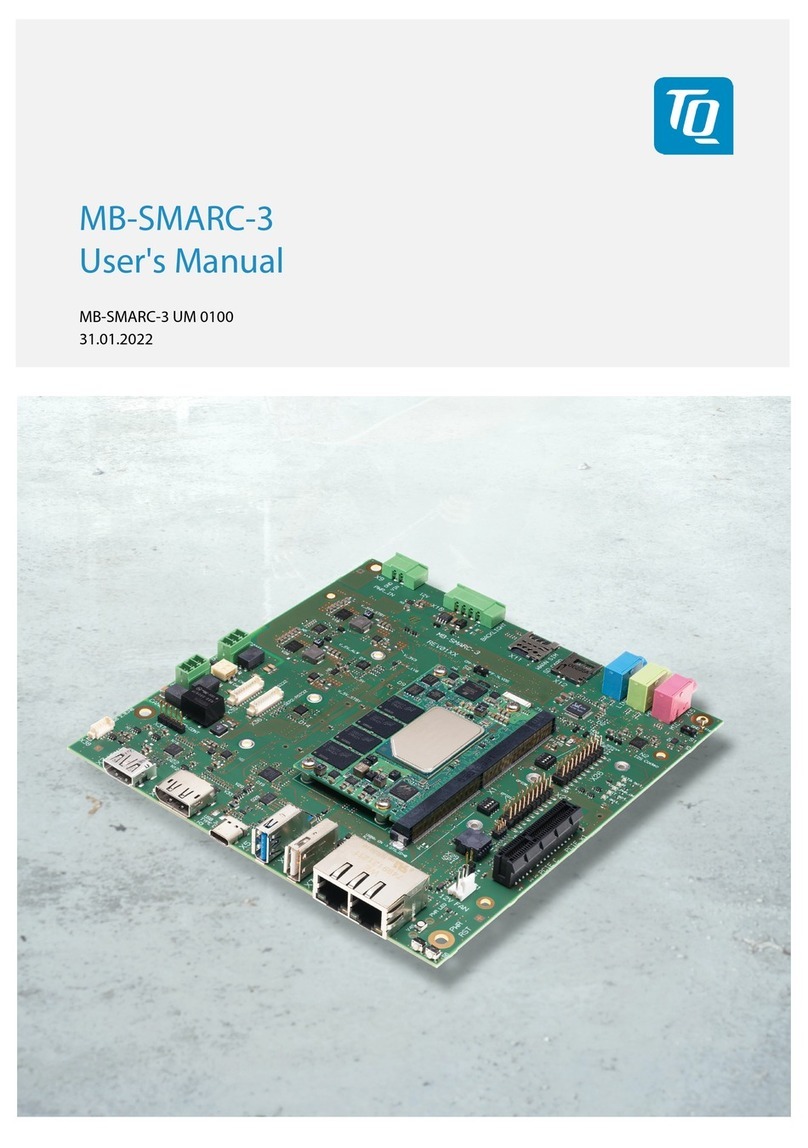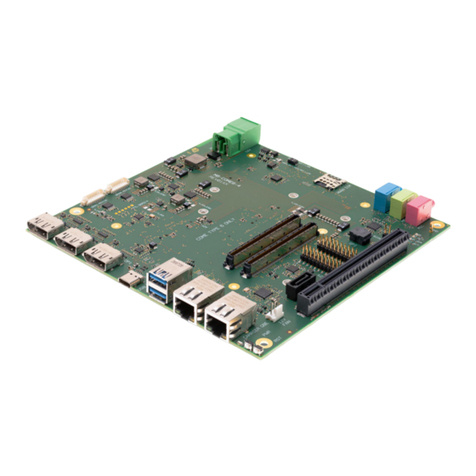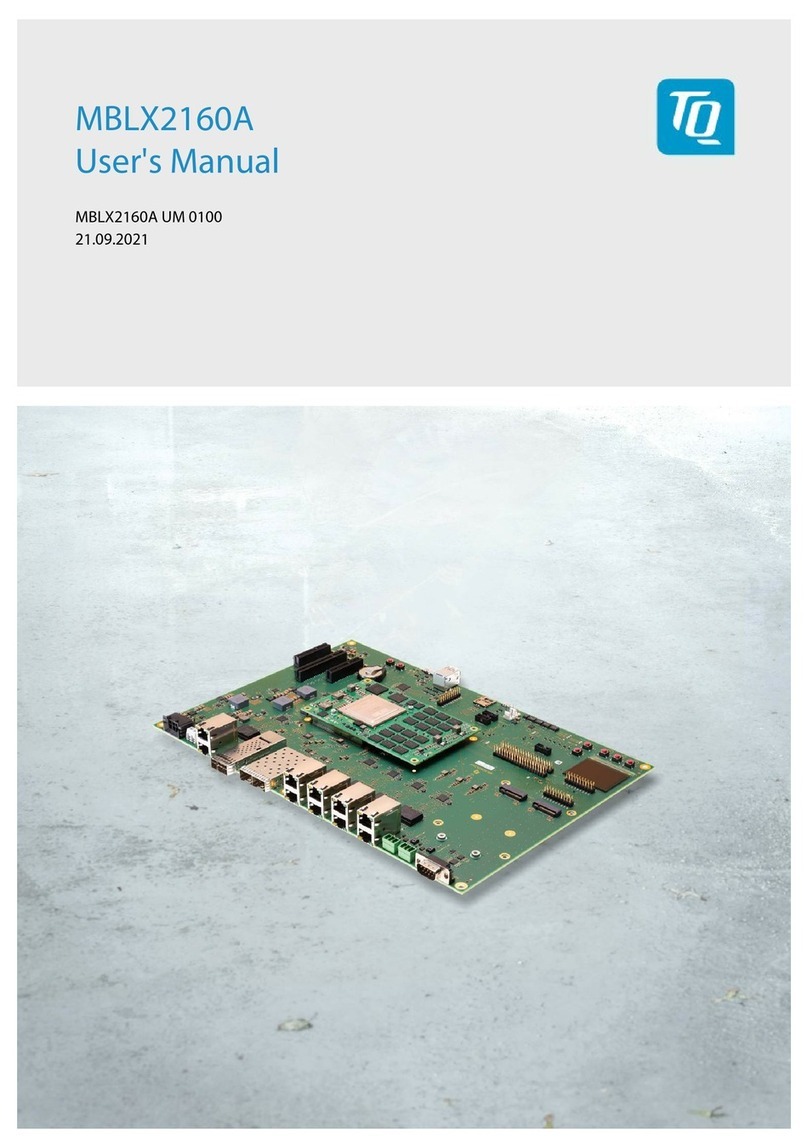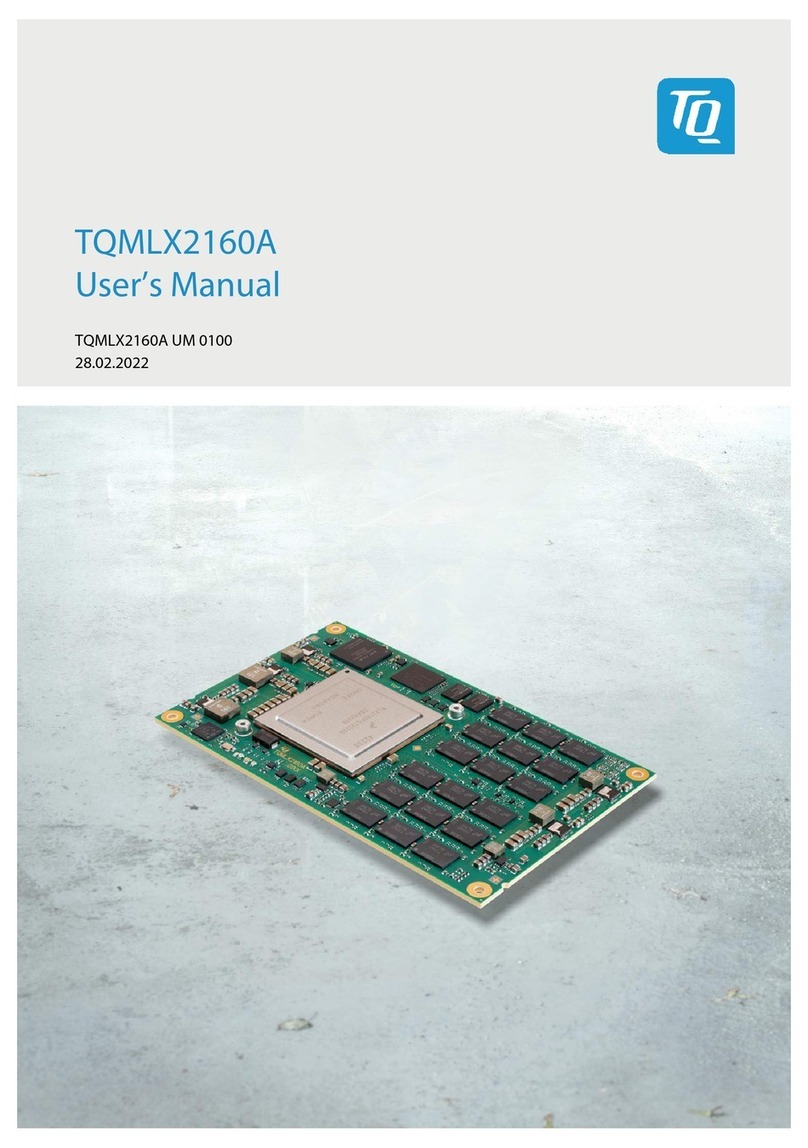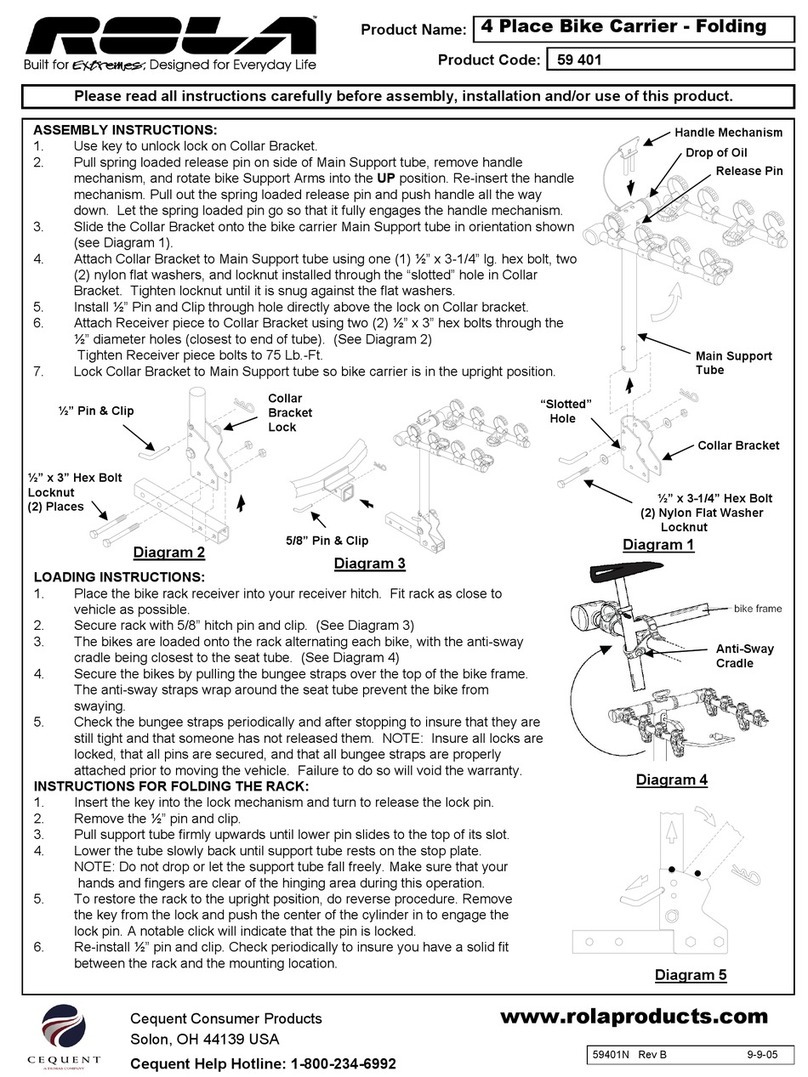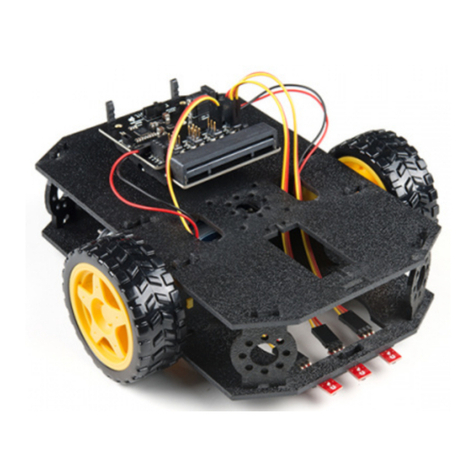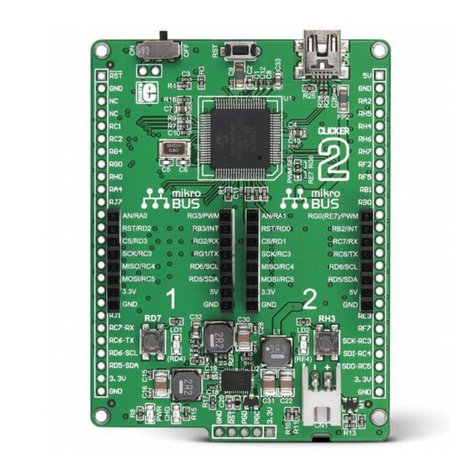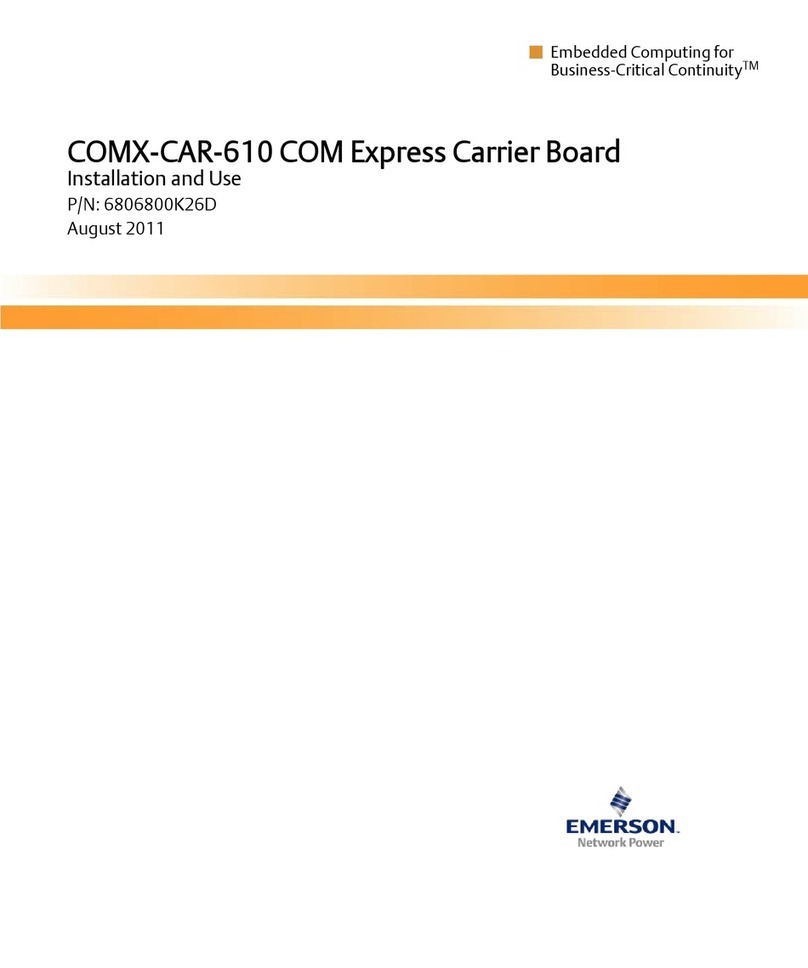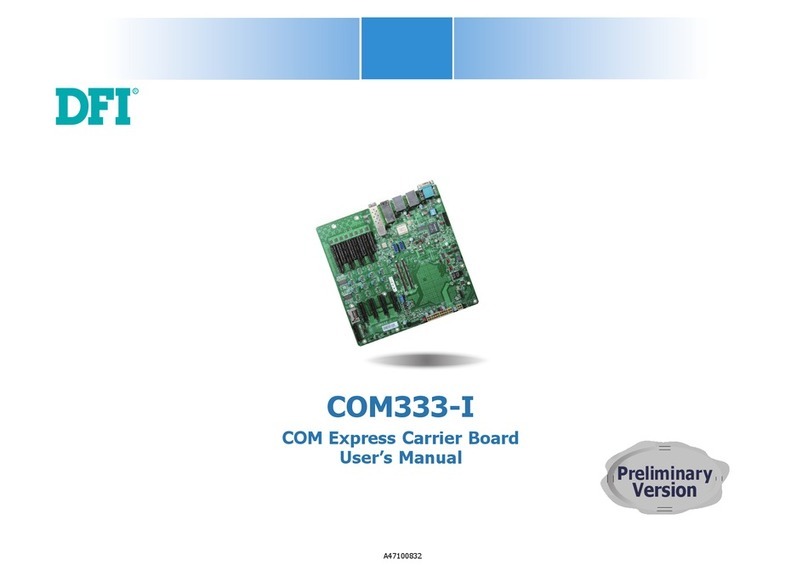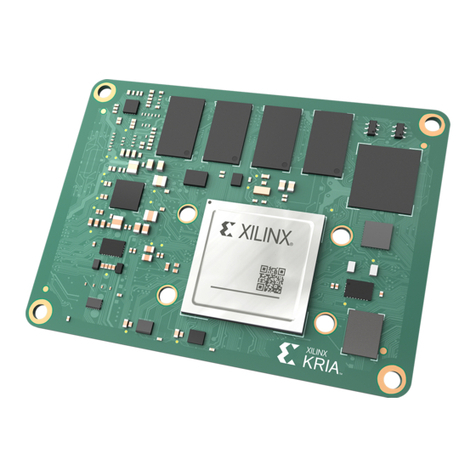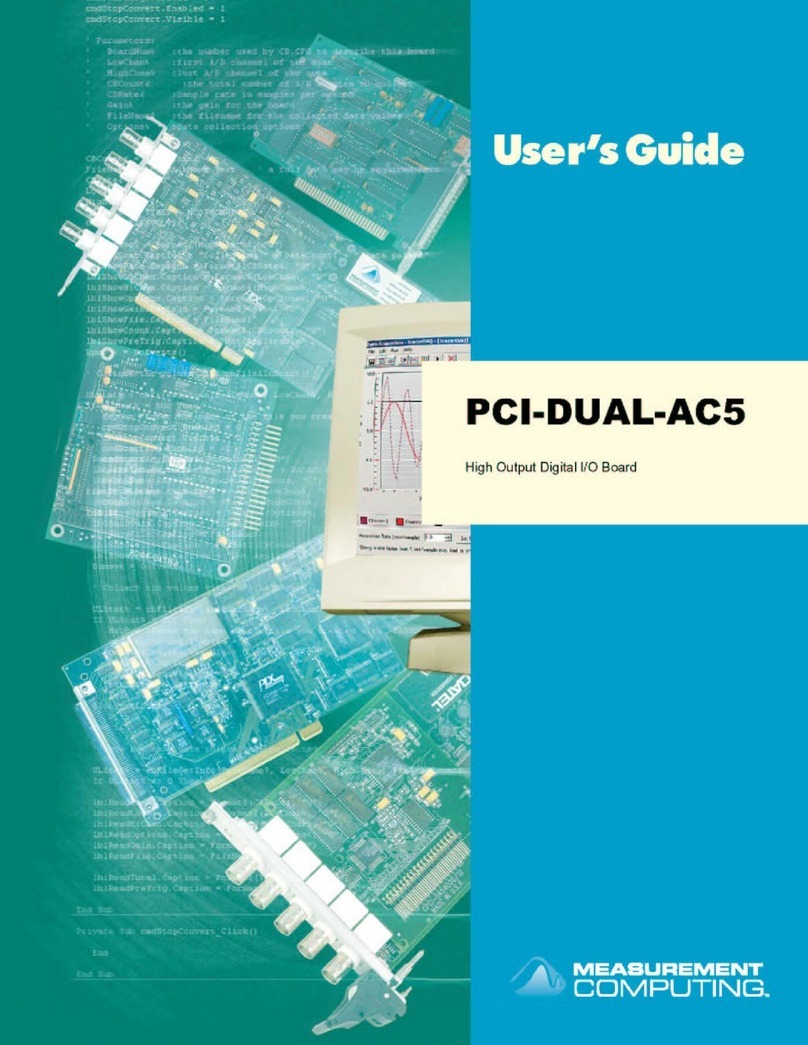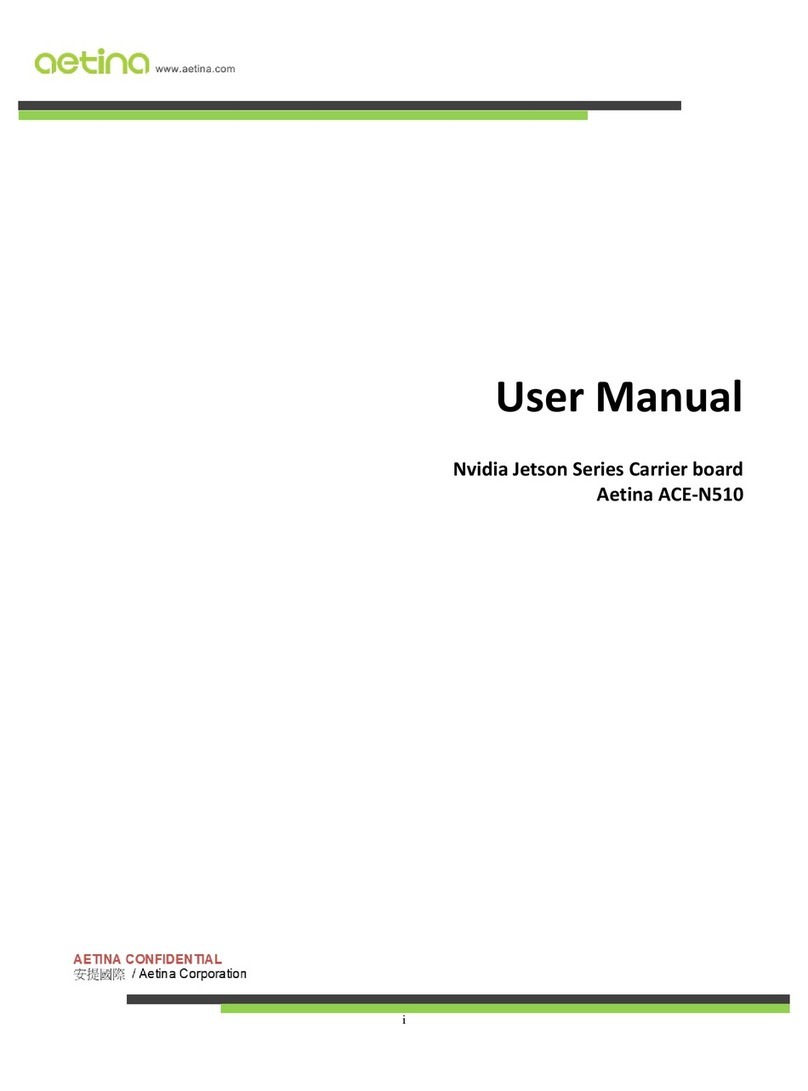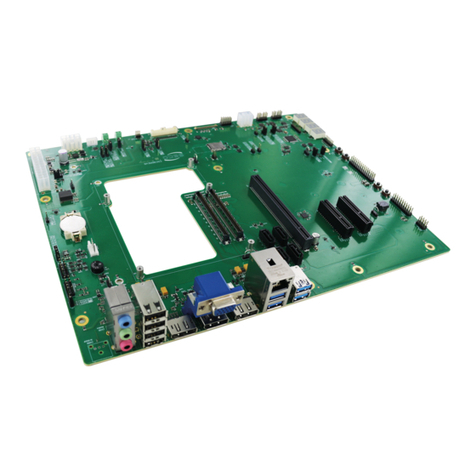TQ TQMa65 Series User manual

TQMa65xx
Preliminary User's Manual
TQMa65xx UM 0001
07.02.2021

Preliminary User's Manual l TQMa65xx UM 0001 l © 2021, TQ-Systems GmbH Page i
TABLE OF CONTENTS
1. ABOUT THIS MANUAL......................................................................................................................................................................................1
1.1 Copyright and license expenses..................................................................................................................................................................1
1.2 Registered trademarks ....................................................................................................................................................................................1
1.3 Disclaimer ............................................................................................................................................................................................................1
1.4 Imprint...................................................................................................................................................................................................................1
1.5 Tips on safety......................................................................................................................................................................................................2
1.6 Symbols and typographic conventions....................................................................................................................................................2
1.7 Handling and ESD tips.....................................................................................................................................................................................2
1.8 Naming of signals..............................................................................................................................................................................................3
1.9 Further applicable documents / presumed knowledge.....................................................................................................................3
2. BRIEF DESCRIPTION ..........................................................................................................................................................................................4
2.1 Block diagram AM65xx....................................................................................................................................................................................5
2.2 Key functions and characteristics................................................................................................................................................................5
3. ELECTRONICS......................................................................................................................................................................................................6
3.1 Interfaces to other systems and devices...................................................................................................................................................6
3.1.1 AM65xx pin multiplexing...............................................................................................................................................................................6
3.1.2 Pinout TQMa65xx..............................................................................................................................................................................................7
3.2 System components .....................................................................................................................................................................................12
3.2.1 AM65xx CPU.....................................................................................................................................................................................................12
3.2.1.1 Boot Mode ........................................................................................................................................................................................................12
3.2.1.2 MCU Boot Mode Selection..........................................................................................................................................................................13
3.2.1.3 Boot Mode pin mapping .............................................................................................................................................................................14
3.2.2 Memory..............................................................................................................................................................................................................16
3.2.2.1 DDR4 SDRAM...................................................................................................................................................................................................16
3.2.2.2 eMMC..................................................................................................................................................................................................................16
3.2.2.3 OSPI NOR flash ................................................................................................................................................................................................17
3.2.2.4 EEPROM .............................................................................................................................................................................................................17
3.2.2.5 EEPROM with temperature sensor...........................................................................................................................................................18
3.2.3 RTC.......................................................................................................................................................................................................................19
3.2.4 Secure Element ...............................................................................................................................................................................................19
3.2.5 I2C devices.........................................................................................................................................................................................................20
3.2.6 Board Controller .............................................................................................................................................................................................20
3.2.7 Reset....................................................................................................................................................................................................................20
3.3 Power..................................................................................................................................................................................................................21
3.3.1 Power supply ...................................................................................................................................................................................................21
3.3.2 TQMa65xx power-up sequencing............................................................................................................................................................21
3.3.3 Power consumption......................................................................................................................................................................................21
3.3.4 Power modes...................................................................................................................................................................................................21
4. MECHANICS......................................................................................................................................................................................................22
4.1 Connectors .......................................................................................................................................................................................................22
4.2 Dimensions.......................................................................................................................................................................................................23
4.3 Component placement................................................................................................................................................................................25
4.4 Protection against external effects..........................................................................................................................................................26
4.5 Thermal management..................................................................................................................................................................................26
4.6 Structural requirements...............................................................................................................................................................................26
4.7 Notes of treatment ........................................................................................................................................................................................26
5. SOFTWARE........................................................................................................................................................................................................26
6. SAFETY REQUIREMENTS AND PROTECTIVE REGULATIONS ............................................................................................................27
6.1 EMC .....................................................................................................................................................................................................................27
6.2 ESD.......................................................................................................................................................................................................................27
6.3 Operational safety and personal security..............................................................................................................................................27
6.4 Shock and vibration ......................................................................................................................................................................................27
6.5 Climate and operational conditions........................................................................................................................................................28
6.6 Reliability and service life............................................................................................................................................................................28

Preliminary User's Manual l TQMa65xx UM 0001 l © 2021, TQ-Systems GmbH Page ii
TABLE OF CONTENTS (continued)
7. ENVIRONMENT PROTECTION.....................................................................................................................................................................29
7.1 RoHS....................................................................................................................................................................................................................29
7.2 WEEE®.................................................................................................................................................................................................................29
7.3 REACH®..............................................................................................................................................................................................................29
7.4 EuP.......................................................................................................................................................................................................................29
7.5 Battery ................................................................................................................................................................................................................29
7.6 Packaging..........................................................................................................................................................................................................29
7.7 Other entries ....................................................................................................................................................................................................29
8. APPENDIX..........................................................................................................................................................................................................30
8.1 Acronyms and definitions...........................................................................................................................................................................30
8.2 References ........................................................................................................................................................................................................32

Preliminary User's Manual l TQMa65xx UM 0001 l © 2021, TQ-Systems GmbH Page iii
TABLE DIRECTORY
Table 1: Terms and conventions ..................................................................................................................................................................................2
Table 2: Pinout TQMa65xx connector X1..................................................................................................................................................................7
Table 3: Pinout TQMa65xx connector X2..................................................................................................................................................................9
Table 4: Pinout TQMa65xx connector X3...............................................................................................................................................................11
Table 5: MCU_BOOTMODE Pin Mapping...............................................................................................................................................................13
Table 6: PLL Reference Clock Selection...................................................................................................................................................................13
Table 7: POST Selection ................................................................................................................................................................................................13
Table 8: 1.8V LDO Configuration...............................................................................................................................................................................13
Table 9: BOOTMODE Pin Mapping ...........................................................................................................................................................................14
Table 10: Primary Boot Mode Selection ....................................................................................................................................................................14
Table 11: Backup Mode Selection ...............................................................................................................................................................................14
Table 12: Min Pin Configuration ..................................................................................................................................................................................15
Table 13: Primary Boot Mode Configuration...........................................................................................................................................................15
Table 14: Backup Boot Mode Configuration ...........................................................................................................................................................15
Table 15: Unsupported eMMC modes.......................................................................................................................................................................16
Table 16: Temperature sensor SE97BTP....................................................................................................................................................................18
Table 17: TQMa65xx WKUP_I2C addresses..............................................................................................................................................................20
Table 18: TQMa65xx connectors..................................................................................................................................................................................22
Table 19: Carrier board mating connectors.............................................................................................................................................................22
Table 20: TQMa65xx, heights .......................................................................................................................................................................................23
Table 21: Labels on TQMa65xx.....................................................................................................................................................................................25
Table 22: Shock resistance .............................................................................................................................................................................................27
Table 23: Vibration resistance.......................................................................................................................................................................................27
Table 24: Climate and operational conditions –25 °C to +85 °C ......................................................................................................................28
Table 25: Climate and operational conditions –40 °C to +85 °C ......................................................................................................................28
Table 26: Acronyms ..........................................................................................................................................................................................................30
Table 27: Further applicable documents..................................................................................................................................................................32
ILLUSTRATION DIRECTORY
Figure 1: Block diagram AM65xx CPU family.............................................................................................................................................................5
Figure 2: Block diagram TQMa65xx ..............................................................................................................................................................................6
Figure 3: Block diagram MMCSD interface..............................................................................................................................................................16
Figure 4:Block diagram OSPI interface.....................................................................................................................................................................17
Figure 5: Block diagram EEPROM................................................................................................................................................................................17
Figure 6: Block diagram temperature sensor interface ......................................................................................................................................18
Figure 7: Block diagram RTC.........................................................................................................................................................................................19
Figure 8: Block diagram Secure Element .................................................................................................................................................................19
Figure 9: Block diagram I2C devices ...........................................................................................................................................................................20
Figure 10: TQMa65xx dimensions, side view ............................................................................................................................................................23
Figure 11: TQMa65xx CPU position, top view...........................................................................................................................................................24
Figure 12: TQMa65xx dimensions, top view through TQMa65xx .....................................................................................................................24
Figure 13: TQMa65xx, component placement top.................................................................................................................................................25
Figure 14: TQMa65xx, component placement bottom.........................................................................................................................................25

Preliminary User's Manual l TQMa65xx UM 0001 l © 2021, TQ-Systems GmbH Page iv
REVISION HISTORY
Rev. Date Name Pos. Modification
0001 07.02.2021 Petz Initial release

Preliminary User's Manual l TQMa65xx UM 0001 l © 2021, TQ-Systems GmbH Page 1
1.
ABOUT THIS MANUAL
1.1
Copyright and license expenses
Copyright protected © 2021 by TQ-Systems GmbH.
This Preliminary User's Manual may not be copied, reproduced, translated, changed or distributed, completely or partially in
electronic, machine readable, or in any other form without the written consent of TQ-Systems GmbH.
The drivers and utilities for the components used as well as the BIOS are subject to the copyrights of the respective
manufacturers. The licence conditions of the respective manufacturer are to be adhered to.
Bootloader-licence expenses are paid by TQ-Systems GmbH and are included in the price.
Licence expenses for the operating system and applications are not taken into consideration and must be calculated / declared
separately.
1.2
Registered trademarks
TQ-Systems GmbH aims to adhere to copyrights of all graphics and texts used in all publications, and strives to use original
or license-free graphics and texts.
All brand names and trademarks mentioned in this Preliminary User's Manual, including those protected by a third party, unless
specified otherwise in writing, are subjected to the specifications of the current copyright laws and the proprietary laws of the
present registered proprietor without any limitation. One should conclude that brand and trademarks are rightly protected by a
third party.
1.3
Disclaimer
TQ-Systems GmbH does not guarantee that the information in this Preliminary User's Manual is up-to-date, correct, complete or
of good quality. Nor does TQ-Systems GmbH assume guarantee for further usage of the information. Liability claims against TQ-
Systems GmbH, referring to material or non-material related damages caused, due to usage or non-usage of the information
given in this Preliminary User's Manual, or due to usage of erroneous or incomplete information, are exempted, as long as there
is no proven intentional or negligent fault of TQ-Systems GmbH.
TQ-Systems GmbH explicitly reserves the rights to change or add to the contents of this Preliminary User's Manual or parts of it
without special notification.
Important Notice:
Before using the MBa65xx or parts of the schematics of the MBa65xx, you must evaluate it and determine if it is suitable for your
intended application. You assume all risks and liability associated with such use. TQ-Systems GmbH makes no other warranties
including, but not limited to, any implied warranty of merchantability or fitness for a particular purpose. Except where prohibited
by law, TQ-Systems GmbH will not be liable for any indirect, special, incidental or consequential loss or damage arising from the
usage of the MBa65xx or schematics used, regardless of the legal theory asserted.
1.4
Imprint
TQ-Systems GmbH
Gut Delling, Mühlstraße 2
D-82229 Seefeld
Tel: +49 8153 9308–0
Fax: +49 8153 9308–4223
E-Mail: Info@TQ-Group
Web: TQ-Group

Preliminary User's Manual l TQMa65xx UM 0001 l © 2021, TQ-Systems GmbH Page 2
1.5
Tips on safety
Improper or incorrect handling of the product can substantially reduce its life span.
1.6
Symbols and typographic conventions
Table 1: Terms and conventions
Symbol Meaning
This symbol represents the handling of electrostatic-sensitive modules and / or components. These
components are often damaged / destroyed by the transmission of a voltage higher than about 50 V.
A human body usually only experiences electrostatic discharges above approximately 3,000 V.
This symbol indicates the possible use of voltages higher than 24 V.
Please note the relevant statutory regulations in this regard.
Non-compliance with these regulations can lead to serious damage to your health and may damage
or destroy the component.
This symbol indicates a possible source of danger.
Ignoring the instructions described can cause health damage, or damage the hardware.
This symbol represents important details or aspects for working with TQ-products.
Command
A font with fixed-width is used to denote commands, contents, file names, or menu items.
1.7
Handling and ESD tips
General handling of your TQ-products
The TQ-product may only be used and serviced by certified personnel who have taken note of the
information, the safety regulations in this document and all related rules and regulations.
A general rule is not to touch the TQ-product during operation. This is especially important when
switching on, changing jumper settings or connecting other devices without ensuring beforehand
that the power supply of the system has been switched off.
Violation of this guideline may result in damage / destruction of the TQMa65xx and be dangerous
to your health.
Improper handling of your TQ-product would render the guarantee invalid.
Proper ESD handling
The electronic components of your TQ-product are sensitive to electrostatic discharge (ESD).
Always wear antistatic clothing, use ESD-safe tools, packing materials etc., and operate your TQ-
product in an ESD-safe environment. Especially when you switch modules on, change jumper settings,
or connect other devices.

Preliminary User's Manual l TQMa65xx UM 0001 l © 2021, TQ-Systems GmbH Page 3
1.8
Naming of signals
A hash mark (#) at the end of the signal name indicates a low-active signal.
Example: RESET#
If a signal can switch between two functions and if this is noted in the name of the signal, the low-active function is marked with
a hash mark and shown at the end.
Example: C / D#
If a signal has multiple functions, the individual functions are separated by slashes when they are important for the wiring.
The identification of the individual functions follows the above conventions.
Example: WE2# / OE#
1.9
Further applicable documents / presumed knowledge
•
Specifications and manual of the modules used:
These documents describe the service, functionality and special characteristics of the module used (incl. BIOS).
•
Specifications of the components used:
The manufacturer’s specifications of the components used, for example CompactFlash cards, are to be taken note of.
They contain, if applicable, additional information that must be taken note of for safe and reliable operation. These
documents are stored at TQ-Systems GmbH.
•
Chip errata:
It is the user's responsibility to make sure all errata published by the manufacturer of each component are taken note of.
The manufacturer’s advice should be followed.
•
Software behaviour:
No warranty can be given, nor responsibility taken for any unexpected software behaviour due to deficient components.
•
General expertise:
Expertise in electrical engineering / computer engineering is required for the installation and the use of the device.
The following documents are required to fully comprehend the following contents:
•MBa65xx circuit diagram
•MBa65xx User’s Manual
•AM65xx Data Sheet
•AM65xx Reference Manual
•U-Boot documentation: www.denx.de/wiki/U-Boot/Documentation
•Yocto documentation: www.yoctoproject.org/docs/
•TQ-Support Wiki: Support-Wiki TQMa65xx

Preliminary User's Manual l TQMa65xx UM 0001 l © 2021, TQ-Systems GmbH Page 4
2.
BRIEF DESCRIPTION
This Preliminary User's Manual describes the hardware of the TQMa65xx Rev. 01xx, in combination with the MBa65xx and refers
to some software settings. The MBa65xx serves as an evaluation board for the TQMa65xx.
A certain TQMa65xx version does not necessarily provide all features described in this Preliminary User's Manual.
This Preliminary User's Manual does also not replace the TI AM65xx Reference Manual (2).
The CPU derivatives feature ARM®Cortex-A53 cores, and two ARM®Cortex-R5F coprocessors. The CPUs also provide a 3D GPU.
The TQMa65xx is a universal Minimodule based on these TI ARM®Cortex-A53 AM65xx CPUs, see also (1), (2).
An AM65xx Cortex-A53 core typically operates at 1.1 GHz.
The TQMa65xx extends the TQ-Systems GmbH product range and offers an outstanding computing performance.
A suitable AM65xx derivative (AM6526, AM6527, AM6528, AM6546, or AM6548) can be selected for each requirement.
All essential CPU signals are routed to the connectors. There are therefore no restrictions for customers using the TQMa65xx
with respect to an integrated customised design. All essential components like CPU, DDR4 SDRAM, eMMC, RTC, EEPROM, power
supply, and power management are already integrated on the TQMa65xx.
The main features of the TQMa65xx are:
•TI AM65xx CPU with up to 4 × ARM®Cortex-A53 and 2 × ARM®Cortex-R5F cores
•CPU derivatives: AM6526, AM6527, AM6528, AM6546, or AM6548
•Up to 4 Gbyte DDR4 SDRAM, optional additional ECC
•Up to 64 Gbyte eMMC NAND flash
•Up to 512 Mbyte OSPI NOR flash (optional)
•64 Kbit EEPROM
•EEPROM + temperature sensor
•On-board RTC
•Secure Element (optional)
•All essential AM65XX signals are routed to the TQMa65xx connectors
•Extended temperature range
•5 V single supply voltage

Preliminary User's Manual l TQMa65xx UM 0001 l © 2021, TQ-Systems GmbH Page 5
2.1
Block diagram AM65xx
Figure 1: Block diagram AM65xx CPU family
(Source: Texas Instruments)
2.2
Key functions and characteristics
The following components are implemented on the TQMa65xx:
•AM6526, AM6527, AM6528, AM6546, or AM6548
•DDR4 SDRAM
•eMMC NAND flash
•OSPI NOR flash
•EEPROM
•EEPROM + Temperature sensor
•RTC
•Reset structure
•Power supply with Power Sequencing (single 5 V supply)
•Voltage monitoring
•Boot configuration
•Three connectors (2 × 220 pins, 1 × 120 pins)

Preliminary User's Manual l TQMa65xx UM 0001 l © 2021, TQ-Systems GmbH Page 6
3.
ELECTRONICS
The information provided in this Preliminary User's Manual is only valid in connection with the tailored boot loader,
which is preinstalled on the TQMa65xx, and the BSP provided by TQ-Systems, see also chapter 5.
Figure 2: Block diagram TQMa65xx
3.1
Interfaces to other systems and devices
3.1.1 AM65xx pin multiplexing
When using the AM65XX signals, the multiple pin configurations by different AM65xx-internal function units must be taken note
of. TI provides a tool showing the multiplexing and simplifies the selection and configuration (TI Pin Mux Tool).
The pin assignment listed in Table 2 to Table 4 refers to the corresponding BSP provided by TQ-Systems
in combination with the MBa65xx.
The electrical and pin characteristics are to be taken from the AM65xx Data Sheet (1), and the AM65xx Reference Manual (2).
Attention: Destruction or malfunction, AM65xx pin multiplexing, TQMa65xx reserved pins
Depending on the configuration, many AM65xx balls can provide several different functions.
Please take note of the information in the AM65xx Reference Manual (2), and the AM65xx Errata (3)
concerning the configuration of these pins before integration or start-up of your carrier board.
Improper programming by operating software can cause malfunctions, deterioration or destruction
of the TQMa65xx. Pins marked with “NC” must never be connected and have to be left open.

Preliminary User's Manual l TQMa65xx UM 0001 l © 2021, TQ-Systems GmbH Page 7
3.1.2 Pinout TQMa65xx
Table 2: Pinout TQMa65xx connector X1
AM65xx
Dir. Level Group Signal Pin Signal Group Level Dir. AM65x
– P 0 V Ground DGND A1 B1 DGND Ground 0 V P –
– P 5 V Power VIN A2 B2 VIN Power 5 V P –
– P 5 V Power VIN A3 B3 VIN Power 5 V P –
– P 5 V Power VIN A4 B4 VIN Power 5 V P –
– P 5 V Power VIN A5 B5 VIN Power 5 V P –
– P 5 V Power VIN A6 B6 VIN Power 5 V P –
–
P
5 V
Power
VIN
A7
B7
VIN
Power
5 V
P
–
– P 5 V Power VIN A8 B8 VIN Power 5 V P –
– P 5 V Power VIN A9 B9 VIN Power 5 V P –
– P 0 V Ground DGND A10 B10 VIN Power 5 V P –
– P 0 V Ground DGND A11 B11 DGND Ground 0 V P –
– P 0 V Ground DGND A12 B12 DGND Ground 0 V P –
– P 0 V Ground DGND A13 B13 DGND Ground 0 V P –
– P 0 V Ground DGND A14 B14 DGND Ground 0 V P –
– P 0 V Ground DGND A15 B15 DGND Ground 0 V P –
– P 0 V Ground DGND A16 B16 DGND Ground 0 V P –
– P 0 V Ground DGND A17 B17 DGND Ground 0 V P –
– P 0 V Ground DGND A18 B18 VDD_SD Power 3.3 V P –
–
P
0 V
Ground
DGND
A19
B19
V_BAT
Power
3.3 V
P
–
– P 1.8 V Power VCC1V8L1 A20 B20 VCC3V3S Power 1.8 / 3.3 V P –
– P 0 V Ground DGND A21 B21 DGND Ground 0 V P –
– P 1.8 V Power VCC1V8 A22 B22 VCC3V3 Power 3.3 V P –
– P 1.8 V Power VCC1V8 A23 B23 VCC3V3 Power 3.3 V P –
– P 0 V Ground DGND A24 B24 DGND Ground 0 V P –
– I 3.3 V JTAG nSRST_JTAG# A25 B25 IO1_RES Factory Test 3.3 V I/O –
– I 1.8 V SYSTEM POR#_MB A26 B26 IO2_RES Factory Test 3.3 V I/O –
C19 O 1.8 / 3.3 V SYSTEM POR#_OUT A27 B27 IO3_RES Factory Test 3.3 V I/O –
– P 0 V Ground DGND A28 B28 RES_BC# Factory Test 3.3 V I –
AH10 I 1.8 V SERDES SERDES1_RXP A29 B29 SWD_CLK Factory Test 3.3 V I –
AG9 I 1.8 V SERDES SERDES1_RXN A30 B30 SWD_DIO Factory Test 3.3 V I/O –
–
P
0 V
Ground
DGND
A31
B31
DGND
Ground
0 V
P
–
AH9 O 1.8 V SERDES SERDES1_TXN_C A32 B32 DGND Ground 0 V P –
AG8 O 1.8 V SERDES SERDES1_TXP_C A33 B33 SERDES0_PCIe_REFCLK0P SERDES 1.8 V O AF10
– P 0 V Ground DGND A34 B34 SERDES0_PCIe_REFCLK0N SERDES 1.8 V O AF9
AE9 O 1.8 V SERDES SERDES1_PCIe_REFCLK1P A35 B35 DGND Ground 0 V P –
AE8 O 1.8 V SERDES SERDES1_PCIe_REFCLK1N A36 B36 SERDES0_RXN SERDES 1.8 V I AH3
– P 0 V Ground DGND A37 B37 SERDES0_RXP SERDES 1.8 V I AG2
AH7 O 1.8 V SERDES SERDES1_REFCLKP A38 B38 DGND Ground 0 V P –
AH6 O 1.8 V SERDES SERDES1_REFCLKN A39 B39 SERDES0_TXP_C SERDES 1.8 V O AG3
– P 0 V Ground DGND A40 B40 SERDES0_TXN_C SERDES 1.8 V O AH4
– P 0 V Ground DGND A41 B41 DGND Ground 0 V P –
AD13 I/O 1.8 / 3.3 V SPI SPI0_D1 A42 B42 SERDES0_REFCLKP SERDES 1.8 V O AG6
AE13 I/O 1.8 / 3.3 V SPI SPI0_D0 A43 B43 SERDES0_REFCLKN SERDES 1.8 V O AG5
– P 0 V Ground DGND A44 B44 DGND Ground 0 V P –
AG12 I/O 1.8 / 3.3 V SPI SPI1_CS1 A45 B45 UART0_CTS# UART 1.8 / 3.3 V I AG11
AD12 I/O 1.8 / 3.3 V SPI SPI1_CS0 A46 B46 UART0_RXD UART 1.8 / 3.3 V I AF11
– P 0 V Ground DGND A47 B47 UART0_TXD UART 1.8 / 3.3 V O AE11
AH13 I/O 1.8 / 3.3 V SPI SPI0_CLK A48 B48 UART0_RST# UART 1.8 / 3.3 V O AD11
– P 0 V Ground DGND A49 B49 DGND Ground 0 V P –
AH12 I/O 1.8 / 3.3 V SPI SPI1_CLK A50 B50 USB0_VBUS_R USB VDDA_3P3_USB
P AE7
– P 0 V Ground DGND A51 B51 DGND Ground 0 V – –
AG13 I/O 1.8 / 3.3 V SPI SPI0_CS0 A52 B52 USB0_ID USB 3.3 V – AF1
AF13 I/O 1.8 / 3.3 V SPI SPI0_CS1 A53 B53 USB0_DRVVBUS USB 1.8 / 3.3 V – AD9
–
P
0 V
Ground
DGND
A54
B54
DGND
Ground
0 V
P
–
AE12 I/O 1.8 / 3.3 V SPI SPI1_D0 A55 B55 USB0_DM USB 3.3 V – AE2

Preliminary User's Manual l TQMa65xx UM 0001 l © 2021, TQ-Systems GmbH Page 8
3.1.2 Pinout TQMa65xx (continued)
Table 2: Pinout TQMa65xx connector X1 (continued)
AM65xx
Dir. Level Group Signal Pin Signal Group Level Dir. AM65x
AF12 I/O 1.8 / 3.3 V SPI SPI1_D1 A56 B56 USB0_DP USB 3.3 V – AF1
– P 0 V Ground DGND A57 B57 DGND Ground 0 V P –
AC3 O 1.8 / 3.3 V CAN MCU_MCAN1_TX A58 B58 USB1_VBUS_R USB VDDA_3P3_USB – AF6
AD3 I 1.8 / 3.3 V CAN MCU_MCAN1_RX A59 B59 USB1_ID USB 3.3 V – AF5
– P 0 V Ground DGND A60 B60 DGND Ground 0 V P –
– P 0 V Ground DGND A61 B61 USB1_DRVVBUS USB 1.8 / 3.3 V – AC8
W2
I
1.8 / 3.3 V
CAN
MCU_MCAN0_RX
A62
B62
DGND
Ground
0 V
P
–
W1 O 1.8 / 3.3 V CAN MCU_MCAN0_TX A63 B63 USB1_DP USB 3.3 V – AE1
– P 0 V Ground DGND A64 B64 USB1_DM USB 3.3 V – AD2
AD6 I/O/D
1.8 / 3.3 V I2C WKUP_I2C_SDA A65 B65 DGND Ground 0 V P –
AC7 I/O/D
1.8 / 3.3 V I2C WKUP_I2C_SCL A66 B66 WKUP_GPIO0_11 GPIO 1.8 / 3.3 V I/O AB2
– P 0 V Ground DGND A67 B67 WKUP_GPIO0_10 GPIO 1.8 / 3.3 V I/O AB3
AD7 I/O/D
1.8 / 3.3 V I2C MCU_I2C_SDA A68 B68 WKUP_GPIO0_9 GPIO 1.8 / 3.3 V I/O AB4
AD8 I/O/D
1.8 / 3.3 V I2C MCU_I2C_SCL A69 B69 WKUP_GPIO0_8 GPIO 1.8 / 3.3 V I/O AC5
– P 0 V Ground DGND A70 B70 DGND Ground 0 V P –
AC1 O 1.8 / 3.3 V UART WKUP_UART0_RTSn A71 B71 WKUP_GPIO0_3 GPIO 1.8 / 3.3 V I/O AD1
AC2 I 1.8 / 3.3 V UART WKUP_UART0_CTSn A72 B72 WKUP_GPIO0_2 GPIO 1.8 / 3.3 V I/O AE3
AB5 O 1.8 / 3.3 V UART WKUP_UART0_TXD A73 B73 WKUP_GPIO0_1 GPIO 1.8 / 3.3 V I/O AF3
AB1
I
1.8 / 3.3 V
UART
WKUP_UART0_RXD
A74
B74
WKUP_GPIO0_0
GPIO
1.8 / 3.3 V
I/O
AF4
– P 0 V Ground DGND A75 B75 WKUP_GPIO0_33 GPIO 1.8 / 3.3 V I/O N3
Y2 I/O 1.8 / 3.3 V SPI MCU_SPI0_D1 A76 B76 DGND Ground 0 V P –
Y3 I/O 1.8 / 3.3 V SPI MCU_SPI0_D0 A77 B77 DGND Ground 0 V P –
Y4 I/O 1.8 / 3.3 V SPI MCU_SPI0_CS0 A78 B78 DGND Ground 0 V P –
Y1 I/O 1.8 / 3.3 V SPI MCU_SPI0_CLK A79 B79 DGND Ground 0 V P –
– P 0 V Ground DGND A80 B80 DGND Ground 0 V P –
N2 I/O 1.8 / 3.3 V GPIO WKUP_GPIO0_32 A81 B81 DGND Ground 0 V P –
P1 I/O 1.8 / 3.3 V GPIO WKUP_GPIO0_31 A82 B82 MCU_POR#_OUT SYSTEM 1.8 / 3.3 V O V2
P3 I/O 1.8 / 3.3 V GPIO WKUP_GPIO0_28 A83 B83 MCU_WARM_RESET#_OUT SYSTEM 1.8 / 3.3 V O V3
P2 I/O 1.8 / 3.3 V GPIO WKUP_GPIO0_27 A84 B84 DGND Ground 0 V P –
R1 I/O 1.8 / 3.3 V GPIO WKUP_GPIO0_26 A85 B85 MCU_RESET#_MB SYSTEM 1.8 / 3.3 V I W4
T1
I/O
1.8 / 3.3 V
GPIO
WKUP_GPIO0_25
A86
B86
MCU_SAFETY_ERROR#
SYSTEM
1.8 / 3.3 V
I/O
W3
– P 0 V Ground DGND A87 B87 DGND Ground 0 V P –
D19 O 1.8 V SYSTEM WARM_RESET#_OUT A88 B88 MCU_UART0_TXD UART 1.8 / 3.3 V O P5
F17 I 1.8 / 3.3 V SYSTEM WARM_RESET#_MB A89 B89 MCU_UART0_RXD UART 1.8 / 3.3 V I P4
– P 0 V Ground DGND A90 B90 DGND Ground 0 V P –
N1 I/O 1.8 / 3.3 V RGMII MCU_RGMII1_TXC A91 B91 MCU_RGMII1_RXC RGMII 1.8 / 3.3 V I M1
N4 O 1.8 / 3.3 V RGMII MCU_RGMII1_TX_CTL A92 B92 MCU_RGMII1_RX_CTL RGMII 1.8 / 3.3 V I N5
M2 O 1.8 / 3.3 V RGMII MCU_RGMII1_TD3 A93 B93 MCU_RGMII1_RD0 RGMII 1.8 / 3.3 V I L6
M3 O 1.8 / 3.3 V RGMII MCU_RGMII1_TD2 A94 B94 MCU_RGMII1_RD1 RGMII 1.8 / 3.3 V I M6
M4 O 1.8 / 3.3 V RGMII MCU_RGMII1_TD1 A95 B95 MCU_RGMII1_RD2 RGMII 1.8 / 3.3 V I L5
M5 O 1.8 / 3.3 V RGMII MCU_RGMII1_TD0 A96 B96 MCU_RGMII1_RD3 RGMII 1.8 / 3.3 V I L2
– P 0 V Ground DGND A97 B97 DGND Ground 0 V P –
L1 O 1.8 / 3.3 V RGMII MCU_RGMII1_MDC A98 B98 DGND Ground 0 V P –
L4 I/O 1.8 / 3.3 V RGMII MCU_RGMII1_MDIO A99 B99 SOC_SAFETY_ERROR# SYSTEM 1.8 V I/O E20
– P 0 V Ground DGND A100 B100 DGND Ground 0 V P –
– P 0 V Ground DGND A101 B101 DGND Ground 0 V P –
H4 A 1.8 V ADC MCU_ADC1_AIN7 A102 B102 MCU_ADC0_AIN7 ADC 1.8 V A J6
G3 A 1.8 V ADC MCU_ADC1_AIN6 A103 B103 MCU_ADC0_AIN6 ADC 1.8 V A J2
G5 A 1.8 V ADC MCU_ADC1_AIN5 A104 B104 MCU_ADC0_AIN5 ADC 1.8 V A J4
F5 A 1.8 V ADC MCU_ADC1_AIN4 A105 B105 MCU_ADC0_AIN4 ADC 1.8 V A K4
H5 A 1.8 V ADC MCU_ADC1_AIN3 A106 B106 MCU_ADC0_AIN3 ADC 1.8 V A J5
G4 A 1.8 V ADC MCU_ADC1_AIN2 A107 B107 MCU_ADC0_AIN2 ADC 1.8 V A J1
G6 A 1.8 V ADC MCU_ADC1_AIN1 A108 B108 MCU_ADC0_AIN1 ADC 1.8 V A J3
F4
A
1.8 V
ADC
MCU_ADC1_AIN0
A109
B109
MCU_ADC0_AIN0
ADC
1.8 V
A
K5
– P 0 V Ground DGND A110 B110 DGND Ground 0 V P –

Preliminary User's Manual l TQMa65xx UM 0001 l © 2021, TQ-Systems GmbH Page 9
3.1.2 Pinout TQMa65xx (continued)
Table 3: Pinout TQMa65xx connector X2
AM65xx
Dir. Level Group Signal Pin Signal Group Level Dir. AM65x
– P 0 V Ground DGND A1 B1 DGND Ground 0 V P –
AE16 O 1.8 / 3.3 V RGMII PRG2_RGMII1_TD3 A2 B2 PRG2_RGMII2_TD3 RGMII 1.8 / 3.3 V O AD14
AF16 O 1.8 / 3.3 V RGMII PRG2_RGMII1_TD2 A3 B3 PRG2_RGMII2_TD2 RGMII 1.8 / 3.3 V O AC15
AG16 O 1.8 / 3.3 V RGMII PRG2_RGMII1_TD1 A4 B4 PRG2_RGMII2_TD1 RGMII 1.8 / 3.3 V O AF14
AH16 O 1.8 / 3.3 V RGMII PRG2_RGMII1_TD0 A5 B5 PRG2_RGMII2_TD0 RGMII 1.8 / 3.3 V O AD15
– P 0 V Ground DGND A6 B6 DGND Ground 0 V P –
AG18
I
1.8 / 3.3 V
RGMII
PRG2_RGMII1_RD3
A7
B7
PRG2_RGMII2_RD3
RGMII
1.8 / 3.3 V
I
AH14
AH17 I 1.8 / 3.3 V RGMII PRG2_RGMII1_RD2 A8 B8 PRG2_RGMII2_RD2 RGMII 1.8 / 3.3 V I AD17
AE18 I 1.8 / 3.3 V RGMII PRG2_RGMII1_RD1 A9 B9 PRG2_RGMII2_RD1 RGMII 1.8 / 3.3 V I AC16
AF18 I 1.8 / 3.3 V RGMII PRG2_RGMII1_RD0 A10 B10 PRG2_RGMII2_RD0 RGMII 1.8 / 3.3 V I AH15
– P 0 V Ground DGND A11 B11 DGND Ground 0 V P –
AG17 I 1.8 / 3.3 V RGMII PRG2_RGMII1_RX_CTL A12 B12 PRG2_RGMII2_RX_CTL RGMII 1.8 / 3.3 V I AG14
AF17 I 1.8 / 3.3 V RGMII PRG2_RGMII1_RXC A13 B13 PRG2_RGMII2_RXC RGMII 1.8 / 3.3 V I AG15
AD16 I/O 1.8 / 3.3 V RGMII PRG2_RGMII1_TXC A14 B14 PRG2_RGMII2_TXC RGMII 1.8 / 3.3 V I/O AE14
AE17 O 1.8 / 3.3 V RGMII PRG2_RGMII1_TX_CTL A15 B15 PRG2_RGMII2_TX_CTL RGMII 1.8 / 3.3 V O AC17
– P 0 V Ground DGND A16 B16 DGND Ground 0 V P –
AG19 O 1.8 / 3.3 V RGMII PRG1_RGMII2_TD3 A17 B17 PRG1_RGMII1_TD3 RGMII 1.8 / 3.3 V O AD19
AH19 O 1.8 / 3.3 V RGMII PRG1_RGMII2_TD2 A18 B18 PRG1_RGMII1_TD2 RGMII 1.8 / 3.3 V O AG20
AF19
O
1.8 / 3.3 V
RGMII
PRG1_RGMII2_TD1
A19
B19
PRG1_RGMII1_TD1
RGMII
1.8 / 3.3 V
O
AH21
AE20 O 1.8 / 3.3 V RGMII PRG1_RGMII2_TD0 A20 B20 PRG1_RGMII1_TD0 RGMII 1.8 / 3.3 V O AH20
– P 0 V Ground DGND A21 B21 DGND Ground 0 V P –
AH22 I 1.8 / 3.3 V RGMII PRG1_RGMII2_RD3 A22 B22 PRG1_RGMII1_RD3 RGMII 1.8 / 3.3 V I AD21
AG21 I 1.8 / 3.3 V RGMII PRG1_RGMII2_RD2 A23 B23 PRG1_RGMII1_RD2 RGMII 1.8 / 3.3 V I AF23
AH23 I 1.8 / 3.3 V RGMII PRG1_RGMII2_RD1 A24 B24 PRG1_RGMII1_RD1 RGMII 1.8 / 3.3 V I AG24
AH24 I 1.8 / 3.3 V RGMII PRG1_RGMII2_RD0 A25 B25 PRG1_RGMII1_RD0 RGMII 1.8 / 3.3 V I AE22
– P 0 V Ground DGND A26 B26 DGND Ground 0 V P –
AE21 I 1.8 / 3.3 V RGMII PRG1_RGMII2_RX_CTL A27 B27 PRG1_RGMII1_RX_CTL RGMII 1.8 / 3.3 V I AG23
AG22 I 1.8 / 3.3 V RGMII PRG1_RGMII2_RXC A28 B28 PRG1_RGMII1_RXC RGMII 1.8 / 3.3 V I AF22
AE19 I/O 1.8 / 3.3 V RGMII PRG1_RGMII2_TXC A29 B29 PRG1_RGMII1_TXC RGMII 1.8 / 3.3 V I/O AD20
AC20 O 1.8 / 3.3 V RGMII PRG1_RGMII2_TX_CTL A30 B30 PRG1_RGMII1_TX_CTL RGMII 1.8 / 3.3 V O AF21
–
P
0 V
Ground
DGND
A31
B31
DGND
Ground
0 V
P
–
AE27 O 1.8 / 3.3 V RGMII PRG0_RGMII2_TD3 A32 B32 PRG0_RGMII1_TD3 RGMII 1.8 / 3.3 V O AA24
AD24 O 1.8 / 3.3 V RGMII PRG0_RGMII2_TD2 A33 B33 PRG0_RGMII1_TD2 RGMII 1.8 / 3.3 V O AD26
AD25 O 1.8 / 3.3 V RGMII PRG0_RGMII2_TD1 A34 B34 PRG0_RGMII1_TD1 RGMII 1.8 / 3.3 V O AC26
AC25 O 1.8 / 3.3 V RGMII PRG0_RGMII2_TD0 A35 B35 PRG0_RGMII1_TD0 RGMII 1.8 / 3.3 V O AD27
– P 0 V Ground DGND A36 B36 DGND Ground 0 V P –
AB26 I 1.8 / 3.3 V RGMII PRG0_RGMII2_RD3 A37 B37 PRG0_RGMII1_RD3 RGMII 1.8 / 3.3 V I AA27
AC27 I 1.8 / 3.3 V RGMII PRG0_RGMII2_RD2 A38 B38 PRG0_RGMII1_RD2 RGMII 1.8 / 3.3 V I W24
AC28 I 1.8 / 3.3 V RGMII PRG0_RGMII2_RD1 A39 B39 PRG0_RGMII1_RD1 RGMII 1.8 / 3.3 V I W25
AB28 I 1.8 / 3.3 V RGMII PRG0_RGMII2_RD0 A40 B40 PRG0_RGMII1_RD0 RGMII 1.8 / 3.3 V I V24
– P 0 V Ground DGND A41 B41 DGND Ground 0 V P –
AA25 I 1.8 / 3.3 V RGMII PRG0_RGMII2_RX_CTL A42 B42 PRG0_RGMII1_RX_CTL RGMII 1.8 / 3.3 V I Y24
AB27 I 1.8 / 3.3 V RGMII PRG0_RGMII2_RXC A43 B43 PRG0_RGMII1_RXC RGMII 1.8 / 3.3 V I Y25
AC24 I/O 1.8 / 3.3 V RGMII PRG0_RGMII2_TXC A44 B44 PRG0_RGMII1_TXC RGMII 1.8 / 3.3 V I/O AD28
AB24 O 1.8 / 3.3 V RGMII PRG0_RGMII2_TX_CTL A45 B45 PRG0_RGMII1_TX_CTL RGMII 1.8 / 3.3 V O AB25
– P 0 V Ground DGND A46 B46 DGND Ground 0 V P –
AH18 O 1.8 / 3.3 V RGMII PRG1_MDIO0_MDC A47 B47 GPIO1_37 GPIO 1.8 / 3.3 V I/O V27
AD18 I/O 1.8 / 3.3 V RGMII PRG1_MDIO0_MDIO A48 B48 PRG0_PRU0_GPO5 GPIO 1.8 / 3.3 V I/O V28
– P 0 V Ground DGND A49 B49 VOUT_DE GPMC 1.8 / 3.3 V O T23
AE15 O 1.8 / 3.3 V RGMII PRG2_MDIO0_MDC A50 B50 VOUT_PCLK GPMC 1.8 / 3.3 V O R24
– P 0 V Ground DGND A51 B51 DGND Ground 0 V P –
AC19 I/O 1.8 / 3.3 V RGMII PRG2_MDIO0_MDIO A52 B52 VOUT_HSYNC GPMC 1.8 / 3.3 V O T24
– P 0 V Ground DGND A53 B53 VOUT_VSYNC GPMC 1.8 / 3.3 V O T25
AE28
O
1.8 / 3.3 V
RGMII
PRG0_MDIO0_MDC
A54
B54
VOUT_DATA23
GPMC
1.8 / 3.3 V
O
R23
AE26 I/O 1.8 / 3.3 V RGMII PRG0_MDIO0_MDIO A55 B55 VOUT_DATA22 GPMC 1.8 / 3.3 V O R26

Preliminary User's Manual l TQMa65xx UM 0001 l © 2021, TQ-Systems GmbH Page 10
3.1.2 Pinout TQMa65xx (continued)
Table 3: Pinout TQMa65xx connector X2 (continued)
AM65xx
Dir. Level Group Signal Pin Signal Group Level Dir. AM65x
– P 0 V Ground DGND A56 B56 VOUT_DATA21 GPMC 1.8 / 3.3 V O P23
AF27 I/O 1.8 / 3.3 V RGMII PRG1_PRU0_GPO5 A57 B57 VOUT_DATA20 GPMC 1.8 / 3.3 V O T28
AF28 I/O 1.8 / 3.3 V GPIO GPIO0_64 A58 B58 VOUT_DATA19 GPMC 1.8 / 3.3 V O U28
AG25 I/O 1.8 / 3.3 V GPIO GPIO0_74 A59 B59 VOUT_DATA18 GPMC 1.8 / 3.3 V O P26
– P 0 V Ground DGND A60 B60 DGND Ground 0 V P –
AH26 I/O 1.8 / 3.3 V GPIO GPIO0_73 A61 B61 VOUT_DATA17 GPMC 1.8 / 3.3 V O P25
AH25
I/O
1.8 / 3.3 V
GPIO
GPIO0_66
A62
B62
VOUT_DATA16
GPMC
1.8 / 3.3 V
O
R28
AG26 I/O 1.8 / 3.3 V GPIO GPIO0_75 A63 B63 VOUT_DATA15 GPMC 1.8 / 3.3 V O R27
AG27 I/O 1.8 / 3.3 V GPIO GPIO0_63 A64 B64 VOUT_DATA14 GPMC 1.8 / 3.3 V O P24
AF25 I/O 1.8 / 3.3 V GPIO GPIO0_85 A65 B65 VOUT_DATA13 GPMC 1.8 / 3.3 V O N25
AF26 I/O 1.8 / 3.3 V GPIO GPIO0_65 A66 B66 VOUT_DATA12 GPMC 1.8 / 3.3 V O N26
AF24 I/O 1.8 / 3.3 V GPIO GPIO0_86 A67 B67 VOUT_DATA11 GPMC 1.8 / 3.3 V O P27
AE24 I/O 1.8 / 3.3 V GPIO GPIO0_84 A68 B68 VOUT_DATA10 GPMC 1.8 / 3.3 V O P28
AE23 I/O 1.8 / 3.3 V GPIO GPIO0_93 A69 B69 VOUT_DATA9 GPMC 1.8 / 3.3 V O M26
– P 0 V Ground DGND A70 B70 DGND Ground 0 V P –
AD22 I/O 1.8 / 3.3 V GPIO GPIO0_94 A71 B71 VOUT_DATA8 GPMC 1.8 / 3.3 V O N23
AD23 I/O 1.8 / 3.3 V GPIO GPIO0_83 A72 B72 VOUT_DATA7 GPMC 1.8 / 3.3 V O M25
AC21 I/O 1.8 / 3.3 V GPIO GPIO0_95 A73 B73 VOUT_DATA6 GPMC 1.8 / 3.3 V O N28
–
P
0 V
Ground
DGND
A74
B74
VOUT_DATA5
GPMC
1.8 / 3.3 V
O
N27
– P 0 V Ground DGND A75 B75 VOUT_DATA4 GPMC 1.8 / 3.3 V O N24
Y26 I/O 1.8 / 3.3 V GPIO GPIO1_67 A76 B76 VOUT_DATA3 GPMC 1.8 / 3.3 V O M24
AA28 I/O 1.8 / 3.3 V GPIO GPIO1_59 A77 B77 VOUT_DATA2 GPMC 1.8 / 3.3 V O M28
Y27 I/O 1.8 / 3.3 V GPIO GPIO1_66 A78 B78 VOUT_DATA1 GPMC 1.8 / 3.3 V O M23
Y28 I/O 1.8 / 3.3 V GPIO GPIO1_58 A79 B79 VOUT_DATA0 GPMC 1.8 / 3.3 V O M27
– P 0 V Ground DGND A80 B80 DGND Ground 0 V P –
W26 I/O 1.8 / 3.3 V GPIO GPIO1_68 A81 B81 DGND Ground 0 V P –
W28 I/O 1.8 / 3.3 V GPIO GPIO1_56 A82 B82 I2C2_SCL I2C 1.8 / 3.3 V I/O/D T27
W27 I/O 1.8 / 3.3 V GPIO GPIO1_57 A83 B83 I2C2_SDA I2C 1.8 / 3.3 V I/O/D R25
V26 I/O 1.8 / 3.3 V GPIO GPIO1_38 A84 B84 DGND Ground 0 V P –
U27 I/O 1.8 / 3.3 V GPIO GPIO1_36 A85 B85 OLDI0_A0P LCD 1.8 V I/O K28
V25
I/O
1.8 / 3.3 V
GPIO
GPIO1_47
A86
B86
OLDI0_A0N
LCD
1.8 V
I/O
J28
U26 I/O 1.8 / 3.3 V GPIO GPIO1_46 A87 B87 DGND Ground 0 V P –
U25 I/O 1.8 / 3.3 V GPIO GPIO1_39 A88 B88 OLDI0_A1P LCD 1.8 V I/O K27
U24 I/O 1.8 / 3.3 V GPIO GPIO1_48 A89 B89 OLDI0_A1N LCD 1.8 V I/O L27
– P 0 V Ground DGND A90 B90 DGND Ground 0 V P –
U23 I/O 1.8 / 3.3 V GPIO PRG0_PRU1_GPO5 A91 B91 DGND Ground 0 V P –
AC22 I/O 1.8 / 3.3 V GPIO PRG1_PRU1_GPO5 A92 B92 OLDI0_A2P LCD 1.8 V I/O J24
A23 I/O 1.8 / 3.3 V GPIO GPIO1_13 A93 B93 OLDI0_A2N LCD 1.8 V I/O K24
B23 I/O 1.8 / 3.3 V GPIO GPIO1_14 A94 B94 DGND Ground 0 V P –
– P 0 V Ground DGND A95 B95 OLDI0_A3P LCD 1.8 V I/O K26
D28 I/O 1.8 / 3.3 V MMC/SD SD_DAT0 A96 B96 OLDI0_A3N LCD 1.8 V I/O J26
E27 I/O 1.8 / 3.3 V MMC/SD SD_DAT1 A97 B97 DGND Ground 0 V P –
D26 I/O 1.8 / 3.3 V MMC/SD SD_DAT2 A98 B98 OLDI0_CLKN LCD 1.8 V I/O L25
D27 I/O 1.8 / 3.3 V MMC/SD SD_DAT3 A99 B99 OLDI0_CLKP LCD 1.8 V I/O K25
– P 0 V Ground DGND A100 B100 DGND Ground 0 V P –
C28 I/O 1.8 / 3.3 V MMC/SD SD_CMD A101 B101 NMI# SYSTEM 1.8 / 3.3 V I F18
C24 I 1.8 / 3.3 V MMC/SD SD_SDWP A102 B102 ECAP0_IN_APWM_OUT PWM 1.8 / 3.3 V I/O D21
B24 I 1.8 / 3.3 V MMC/SD SD_SDCD A103 B103 TIMER_IO1 TIMER 1.8 / 3.3 V I/O C23
C27 O 1.8 / 3.3 V MMC/SD SD_CLK_R A104 B104 TIMER_IO0 TIMER 1.8 / 3.3 V I/O B22
– P 0 V Ground DGND A105 B105 DGND Ground 0 V P –
– P 0 V Ground DGND A106 B106 I2C0_SDA I2C 1.8 / 3.3 V I/O/D C21
A22 I 1.8 / 3.3 V SYSTEM EXT_REFCLK1 A107 B107 I2C0_SCL I2C 1.8 / 3.3 V I/O/D D20
– P 0 V Ground DGND A108 B108 I2C1_SDA I2C 1.8 / 3.3 V I/O/D E21
AD15
O
1.8 V
SYSTEM
OSC1
A109
B109
I2C1_SCL
I2C
1.8 / 3.3 V
I
B21
– P 0 V Ground DGND A110 B110 DGND Ground 0 V P –

Preliminary User's Manual l TQMa65xx UM 0001 l © 2021, TQ-Systems GmbH Page 11
3.1.2 Pinout TQMa65xx (continued)
Table 4: Pinout TQMa65xx connector X3
AM65xx
Dir. Level Group Signal Pin Signal Group Level Dir. AM65x
–
P
0 V
Ground
DGND
A1
B1
DGND
Ground
0 V
P
–
V1
O
1.8 / 3.3 V
XSPI
XSPI_CLK
A2
B2
NC
NC
–
–
–
–
P
0 V
Ground
DGND
A3
B3
NC
NC
–
–
–
R4
O
1.8 / 3.3 V
XSPI
XSPI_CS0
A4
B4
NC
NC
–
–
–
U2
I
1.8 / 3.3 V
XSPI
XSPI_DQS
A5
B5
NC
NC
–
–
–
–
P
0 V
Ground
DGND
A6
B6
DGND
Ground
0 V
P
–
U4
I/O
1.8 / 3.3 V
XSPI
XSPI_DQ0
A7
B7
NC
NC
–
–
–
U5
I/O
1.8 / 3.3 V
XSPI
XSPI_DQ1
A8
B8
NC
NC
–
–
–
T2
I/O
1.8 / 3.3 V
XSPI
XSPI_DQ2
A9
B9
NC
NC
–
–
–
T3
I/O
1.8 / 3.3 V
XSPI
XSPI_DQ3
A10
B10
NC
NC
–
–
–
T4
I/O
1.8 / 3.3 V
XSPI
XSPI_DQ4
A11
B11
NC
NC
–
–
–
T5
I/O
1.8 / 3.3 V
XSPI
XSPI_DQ5
A12
B12
NC
NC
–
–
–
R2
I/O
1.8 / 3.3 V
XSPI
XSPI_DQ6
A13
B13
NC
NC
–
–
–
R3
I/O
1.8 / 3.3 V
XSPI
XSPI_DQ7
A14
B14
NC
NC
–
–
–
R5
O
1.8 / 3.3 V
XSPI
XSPI_CS1
A15
B15
NC
NC
–
–
–
–
P
0 V
Ground
DGND
A16
B16
DGND
Ground
0 V
P
–
U1
O
1.8 / 3.3 V
XSPI
XSPI_LBCLKO
A17
B17
JTAG_EMU1
JTAG
1.8 / 3.3 V
I/O
AA1
–
P
0 V
Ground
DGND
A18
B18
JTAG_EMU0
JTAG
1.8 / 3.3 V
I/O
AA1
–
–
–
NC
NC
A19
B19
JTAG_TRST#
JTAG
1.8 / 3.3 V
I
AA3
–
–
–
NC
NC
A20
B20
DGND
Ground
0 V
P
–
–
–
–
NC
NC
A21
B21
JTAG_TCK
JTAG
1.8 / 3.3 V
I
AA4
–
–
–
NC
NC
A22
B22
DGND
Ground
0 V
P
–
–
–
–
NC
NC
A23
B23
JTAG_TDO
JTAG
1.8 / 3.3 V
O/Z
A20
–
–
–
NC
NC
A24
B24
JTAG_TMS
JTAG
1.8 / 3.3 V
I
A21
–
–
–
NC
NC
A25
B25
JTAG_TDI
JTAG
1.8 / 3.3 V
I
C20
–
P
0 V
Ground
DGND
A26
B26
DGND
Ground
0 V
P
–
–
–
–
NC
NC
A27
B27
SE_ISO_7816_IO1
SECURITY
3.3 V
I/O
–
–
–
–
NC
NC
A28
B28
SE_ISO_7816_IO2
SECURITY
3.3 V
I/O
–
–
–
–
NC
NC
A29
B29
SE_ISO_14443_LA
SECURITY
–
I/O
–
–
–
–
NC
NC
A30
B30
SE_ISO_14443_LB
SECURITY
–
I/O
–
–
–
–
NC
NC
A31
B31
SE_ISO_7816_RST#
SECURITY
3.3 V
I
–
–
–
–
NC
NC
A32
B32
DGND
Ground
0 V
P
–
–
–
–
NC
NC
A33
B33
SE_ISO_7816_CLK
SECURITY
3.3 V
I
–
–
–
–
NC
NC
A34
B34
DGND
Ground
0 V
P
–
–
P
0 V
Ground
DGND
A35
B35
DGND
Ground
0 V
P
–
B25
O
1.8 / 3.3 V
MMC/SD
eMMC_CLK
A36
B36
NC
NC
–
–
–
–
P
0 V
Ground
DGND
A37
B37
NC
NC
–
–
–
B27
O
1.8 / 3.3 V
MMC/SD
eMMC_CMD
A38
B38
NC
NC
–
–
–
C25
I
1.8 / 3.3 V
MMC/SD
eMMC_DS
A39
B39
NC
NC
–
–
–
A26
I/O
1.8 / 3.3 V
MMC/SD
eMMC_DAT0
A40
B40
NC
NC
–
–
–
E25
I/O
1.8 / 3.3 V
MMC/SD
eMMC_DAT1
A41
B41
DGND
Ground
0 V
P
–
C26
I/O
1.8 / 3.3 V
MMC/SD
eMMC_DAT2
A42
B42
DGND
Ground
0 V
P
–
A25
I/O
1.8 / 3.3 V
MMC/SD
eMMC_DAT3
A43
B43
CSI0_RXN4
CSI
1.8 V
I
G24
E24
I/O
1.8 / 3.3 V
MMC/SD
eMMC_DAT4
A44
B44
CSI0_RXP4
CSI
1.8 V
I
F24
–
P
0 V
Ground
DGND
A45
B45
DGND
Ground
0 V
P
–
B24
I/O
1.8 / 3.3 V
MMC/SD
eMMC_DAT5
A46
B46
CSI0_RXN3
CSI
1.8 V
I
H25
B26
I/O
1.8 / 3.3 V
MMC/SD
eMMC_DAT6
A47
B47
CSI0_RXP3
CSI
1.8 V
I
G25
D25
I/O
1.8 / 3.3 V
MMC/SD
eMMC_DAT7
A48
B48
DGND
Ground
0 V
P
–
–
P
0 V
Ground
DGND
A49
B49
CSI0_RXN2
CSI
1.8 V
I
F26
–
–
–
NC
NC
A50
B50
CSI0_RXP2
CSI
1.8 V
I
G26
–
–
–
NC
NC
A51
B51
DGND
CSI
0 V
P
–
–
–
–
NC
NC
A52
B52
CSI0_RXN1
CSI
1.8 V
I
H27
–
–
–
NC
NC
A53
B53
CSI0_RXP1
CSI
1.8 V
I
G27
–
–
–
NC
NC
A54
B54
DGND
Ground
0 V
P
–
–
P
0 V
Ground
DGND
A55
B55
DGND
Ground
0 V
P
–
–
–
–
NC
NC
A56
B56
CSI0_RXN0
CSI
1.8 V
I
G28
–
–
–
NC
NC
A57
B57
CSI0_RXP0
CSI
1.8 V
I
F28
–
–
–
NC
NC
A58
B58
DGND
Ground
0 V
P
–
–
–
–
NC
NC
A59
B59
DGND
Ground
0 V
P
–
–
P
0 V
Ground
DGND
A60
B60
DGND
Ground
0 V
P
–

Preliminary User's Manual l TQMa65xx UM 0001 l © 2021, TQ-Systems GmbH Page 12
3.2
System components
3.2.1 AM65xx CPU
Depending on the TQMa65xx version, one of the following AM65xx derivatives is assembled:
•AM6526
•AM6527
•AM6528
•AM6546
•AM6548
Attention: Destruction or malfunction, AM65xx errata
Please take note of the current AM65xx errata (3).
Attention: MMCSD peripherals, no HS400 mode
MMCSD peripherals do not support the Multimedia Card HS400 mode.
Please take note of the current AM65xx errata (3).
3.2.1.1 Boot Mode
The Boot Mode configuration of the AM65xx is selected via boot strapping pins when the reset is released.
At this time the correct levels must be applied to the corresponding AM65XX pins to ensure the desired configuration.
More information about boot interfaces and its configuration is to be taken from the AM65xx Data Sheet (1) and the AM65xx
Reference Manual (2).
Standard boot devices are, e.g. the eMMC or the QSPI NOR flash on the TQMa65xx, or an SD card on the carrier board.
The boot configuration pins are multiplexed. For this reason, tri-state buffers should be used for other usage of these pins.
Note: Field software updates
When designing a carrier board, it is recommended to have a redundant update concept for field
software updates.

Preliminary User's Manual l TQMa65xx UM 0001 l © 2021, TQ-Systems GmbH Page 13
3.2.1.2 MCU Boot Mode Selection
The MCU_BOOTMODE[9:0] pins have to be configured on the carrier board (e.g., MBa65xx).
Table 5: MCU_BOOTMODE Pin Mapping
9 8 7 6 5 4 3 2 1 0
1.8 V
MMC/SD POST 1Reserved 2Ref Clock
Table 6: PLL Reference Clock Selection
MCU_BOOTMODE Pins Ref Clock (MHz)
2 1 0
0 0 0 19.2
0 0 1 20
0 1 0 24
0 1 1 25
1 0 0 26
1 0 1 27
1 1 0 Reserved
1 1 1 No PLL configuration (slow speed backup)
Table 7: POST Selection
MCU_BOOTMODE Pins POST Select
8 7 6 5
0 0 0 0 POST bypass
X X X 1 Enable POST DMSC, MCU LBIST Parallel
X X 1 X POST DMSC LBIST Enable
X 1 X X POST MCU LBIST Enable
1 X X X POST PBIST Enable
Table 8: 1.8V LDO Configuration
MCU_BOOTMODE Pin 1.8V MMC/SD
9
0 MMCSD0 connected to 1.8V LDO
1 MMCSD1 connected to 1.8V LDO
1: Only on safety-enabled devices. Refer to device Datasheet for device nomenclature.
2: Always set to 0s (via pulldowns to VSS).

Preliminary User's Manual l TQMa65xx UM 0001 l © 2021, TQ-Systems GmbH Page 14
3.2.1.3 Boot Mode pin mapping
In normal boot operation the ROM execution is directed through the main BOOTMODE[18:0] pins.
Table 9: BOOTMODE Pin Mapping
18 17 16 15 14 13 12 11 10 9 8 7 6 5 4 3 2 1 0
Backup Config Primary Config Min Backup Mode Primary Mode
Table 10: Primary Boot Mode Selection
BOOTMODE Pins
Primary Boot Mode Selected
3 2 1 0
0 0 0 0 Sleep (No boot – debug mode)
0 0 0 1 OSPI
0 0 1 0 QSPI
0 0 1 1 Hyperflash
0 1 0 0 SPI (on QSPI/OSPI port 0 in legacy SPI mode)
0 1 0 1 I2C
0 1 1 0 MMC/SD card, eMMC boot from UDA or file system
0 1 1 1 Ethernet
1 0 0 0 USB
1 0 0 1 PCIe
1 0 1 0 UART
1 0 1 1 Reserved
1 1 0 0 GPMC NOR
1 1 0 1 eMMC boot from boot partition (with auto-fall back to file system)
1 1 1 0 Reserved (acts as Sleep)
1 1 1 1 Reserved (acts as Sleep)
Table 11: Backup Mode Selection
BOOTMODE Pins Backup Boot Mode Selected
6 5 4
0 0 0 None (no backup boot will be attempted)
0 0 1 USB
0 1 0 UART
0 1 1 Ethernet
1 0 0 MMC/SD
1 0 1 SPI (on OSPI port 0 in legacy SPI mode)
1 1 0 Hyperflash
1 1 1 I2C

Preliminary User's Manual l TQMa65xx UM 0001 l © 2021, TQ-Systems GmbH Page 15
3.2.1.3 Boot Mode pin mapping (continued)
Table 12: Min Pin Configuration
BOOTMODE Pin
Min Pin Configuration
7
0 All boot mode pins must be properly set
1 Certain boot mode pins are don't cares. ROM code uses built-in values instead.
Table 13: Primary Boot Mode Configuration
BOOTMODE Pins 3
Boot Mode Description
15
14
13
12
11
10
9
8
3 – 0
0000 Sleep Boot not attempted
Pin Cmd Iclk Csel Speed Addr
Width 0001 OSPI –
Port Pin
Cmd Iclk Csel Speed Addr
Width 0010 QSPI –
ns Csel Speed 0011 Hyperflash –
Port Mode Csel Read
Cmd Addr Width 0100 SPI –
Bus Reset Mode Speed Addr 0101 I2C –
Volt Port Interface Config 1bit 0110 MMC/SD –
Clken Clkf Interface Speed Duplex Extern conf 0111 Ethernet –
Mode Port 1000 USB –
Port Dual Sref 1001 PCIe –
1010 UART –
Base A/D mux Csel Size Csel Bus
Width 1100 GPMC NOR –
Port Alt Bus Width Speed Ack 1101 eMMC –
Table 14: Backup Boot Mode Configuration
BOOTMODE Pins 3
Backup Boot Mode Description
18
17
16
6 – 4
000 None No backup boot performed
Mode Port 001 USB –
010 UART –
Clkout Interface 011 Ethernet –
Volt Port 1bit 100 MMC/SD –
Port Addr Width/Cmd 101 SPI –
Csel Speed 110 Hyperflash –
Bus Reset Mode Addr 111 I2C –
3: Shaded cells are don’t cares and pins can take any value.
Table of contents
Other TQ Carrier Board manuals
